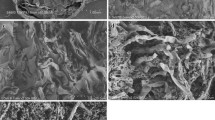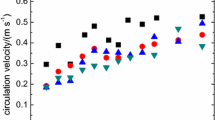Summary
The cytoplasmic hydrogenase from Alcaligenes eutrophus (E.C.1.12.1.2.) was used to achieve continuous NADH regeneration. Cells were grown under heterotrophic conditions in a medium containing fructose and glycerol as carbon sources. A cell suspension with about 1 unit/ml activity was obtained. The enzyme was purified 20 fold with a 72 % yield and a final specific activity of 21 units/mg. The hydrogenase was covalently grafted onto corn stover particles for reactor application. The immobilized derivative shows a higher stability than the free enzyme. This hydrogenase preparation was used in combination with L-lactate dehydrogenase, to achieve the continuous reduction of pyruvate into lactate. For this purpose, both enzymes were simultaneously immobilized onto corn stover. Continuous NADH regeneration could thus be obtained over periods of time lasting over 45 hours, corresponding to 111 NADH regeneration cycles.
Similar content being viewed by others
References
Danielsson, B., Winquist, F., Malpote, J.Y., and Mosbach, K. (1982). Biotechnol.Lett. 4, 10, 673–678.
Friedrich, B., Heine, E., Finck, A., and Friedrich, C.G. (1981). J. Bacteriol. 145, 1144–1149.
Friedrich, C.G., Schneider, K., and Friedrich, B. (1982). J.Bacteriol. 152, 42–48.
Jones, J.B., and Beck, J.F. (1976). Asymetric syntheses and resolutions using enzymes. In: Applications of biochemical systems in organic chemistry, J.B. Jones, C.J. Sih and D. Perlman, eds. Vol. 10, part 1, pp 370–376. John Wiley and Sons, New York.
Klibanov, A.M., and Puglisi, A.V. (1980). Biotechnol.Lett. 2, 10, 445–450.
Lowe, C.R. (1981). Immobilized coenzymes. In: Topics in enzyme and fermentation biotechnology, A. Wiseman, ed. Vol. 5, pp 112–115. Halsted Press. New York.
Monsan, P. (1979). Enzymes immobilisées sur un support solide. French patent n∘ 79-31382.
Pinchukova, E.E., and Varfolomeev, S.D. (1980). Biokhimiya 45, 8, 1405–1411.
Schneider, K., and Schlegel, H.G. (1976). Biochem.Biophys.Acta, 452, 66–80.
Schneider, K., and Schlegel, H.G. (1981). Biochem.J. 193, 99–107.
Simon, H., Egerer, P., and Günther, H. (1978). In: Hydrogenases: their catalytic activity, structure and function, K. Schneider and H.G. Schlegel, eds., pp 235–251, Erick Goltze K.G., Göttingen.
Wandrey, D., and Wichman, R. (1981). Biotechnol.Bioeng. 23, 2789–2802.
Wang, S.S., and King, C.K. (1979). The use of coenzymes in biochemical reactors. In: Advances in Biochemical Engineering, T.K. Ghose, A. Fiechter and N. Blakebrough, eds. Vol. 12, pp 119–131. Springer-Verlag, Berlin.




